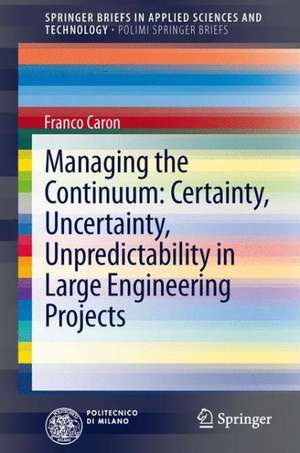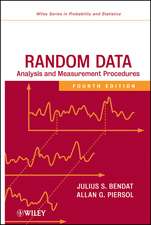Managing the Continuum: Certainty, Uncertainty, Unpredictability in Large Engineering Projects: SpringerBriefs in Applied Sciences and Technology
Autor Franco Caronen Limba Engleză Paperback – 6 iun 2013
Din seria SpringerBriefs in Applied Sciences and Technology
-
 Preț: 380.29 lei
Preț: 380.29 lei - 17%
 Preț: 360.34 lei
Preț: 360.34 lei - 20%
 Preț: 386.12 lei
Preț: 386.12 lei -
 Preț: 380.07 lei
Preț: 380.07 lei -
 Preț: 377.95 lei
Preț: 377.95 lei -
 Preț: 382.32 lei
Preț: 382.32 lei -
 Preț: 376.59 lei
Preț: 376.59 lei -
 Preț: 379.09 lei
Preț: 379.09 lei -
 Preț: 378.12 lei
Preț: 378.12 lei - 20%
 Preț: 293.83 lei
Preț: 293.83 lei -
 Preț: 344.90 lei
Preț: 344.90 lei -
 Preț: 321.36 lei
Preț: 321.36 lei -
 Preț: 264.79 lei
Preț: 264.79 lei -
 Preț: 344.90 lei
Preț: 344.90 lei -
 Preț: 356.46 lei
Preț: 356.46 lei -
 Preț: 382.95 lei
Preț: 382.95 lei -
 Preț: 355.66 lei
Preț: 355.66 lei -
 Preț: 479.67 lei
Preț: 479.67 lei -
 Preț: 415.18 lei
Preț: 415.18 lei -
 Preț: 444.52 lei
Preț: 444.52 lei - 20%
 Preț: 301.86 lei
Preț: 301.86 lei -
 Preț: 409.43 lei
Preț: 409.43 lei - 20%
 Preț: 322.17 lei
Preț: 322.17 lei -
 Preț: 355.49 lei
Preț: 355.49 lei - 15%
 Preț: 462.51 lei
Preț: 462.51 lei -
 Preț: 377.18 lei
Preț: 377.18 lei -
 Preț: 355.93 lei
Preț: 355.93 lei -
 Preț: 382.95 lei
Preț: 382.95 lei -
 Preț: 378.12 lei
Preț: 378.12 lei -
 Preț: 378.12 lei
Preț: 378.12 lei -
 Preț: 380.07 lei
Preț: 380.07 lei -
 Preț: 380.07 lei
Preț: 380.07 lei - 20%
 Preț: 326.28 lei
Preț: 326.28 lei -
 Preț: 312.68 lei
Preț: 312.68 lei -
 Preț: 356.43 lei
Preț: 356.43 lei -
 Preț: 412.30 lei
Preț: 412.30 lei - 20%
 Preț: 225.31 lei
Preț: 225.31 lei -
 Preț: 378.12 lei
Preț: 378.12 lei -
 Preț: 376.59 lei
Preț: 376.59 lei -
 Preț: 195.87 lei
Preț: 195.87 lei -
 Preț: 376.22 lei
Preț: 376.22 lei - 20%
 Preț: 324.64 lei
Preț: 324.64 lei - 20%
 Preț: 288.73 lei
Preț: 288.73 lei -
 Preț: 377.57 lei
Preț: 377.57 lei -
 Preț: 261.91 lei
Preț: 261.91 lei -
 Preț: 381.98 lei
Preț: 381.98 lei -
 Preț: 273.64 lei
Preț: 273.64 lei -
 Preț: 410.87 lei
Preț: 410.87 lei -
 Preț: 379.68 lei
Preț: 379.68 lei -
 Preț: 374.30 lei
Preț: 374.30 lei
Preț: 376.80 lei
Nou
Puncte Express: 565
Preț estimativ în valută:
72.11€ • 78.30$ • 60.57£
72.11€ • 78.30$ • 60.57£
Carte tipărită la comandă
Livrare economică 22 aprilie-06 mai
Preluare comenzi: 021 569.72.76
Specificații
ISBN-13: 9788847052437
ISBN-10: 8847052432
Pagini: 96
Ilustrații: VIII, 88 p. 13 illus.
Dimensiuni: 155 x 235 x 5 mm
Greutate: 0.15 kg
Ediția:2013
Editura: Springer
Colecția Springer
Seriile SpringerBriefs in Applied Sciences and Technology, PoliMI SpringerBriefs
Locul publicării:Milano, Italy
ISBN-10: 8847052432
Pagini: 96
Ilustrații: VIII, 88 p. 13 illus.
Dimensiuni: 155 x 235 x 5 mm
Greutate: 0.15 kg
Ediția:2013
Editura: Springer
Colecția Springer
Seriile SpringerBriefs in Applied Sciences and Technology, PoliMI SpringerBriefs
Locul publicării:Milano, Italy
Public țintă
ResearchCuprins
Introduction.- Large Engineering Projects Strategy.- Large Engineering Projects - the Oil and Gas Case.- Project Management.- Improving the Forecasting Process in Project Control.- Robustness and Flexibility.- Project Risk Analysis and Management.- Real Options.- Stakeholders as Uncertainty Sources.- Project Organizational Model.- Introduction to Project Risk.- Project Risk Analysis.- Project Risk Management.- Quantitative Analysis of Project Risks.- Conclusions.
Textul de pe ultima copertă
The brief will describe how to develop a risk analysis applied to a project , through a sequence of steps: risk management planning, risk identification, risk classification, risk assessment, risk quantification, risk response planning, risk monitoring and control, process close out and lessons learning. The project risk analysis and management process will be applied to large engineering projects, in particular related to the oil and gas industry. The brief will address the overall range of possible events affecting the project moving from certainty (project issues) through uncertainty (project risks) to unpredictability (unforeseeable events), considering both negative and positive events. Some quantitative techniques (simulation, event tree, Bayesian inference, etc.) will be used to develop risk quantification. The brief addresses a typical subject in the area of project management, with reference to large engineering projects concerning the realization of large plants and infrastructures. These projects are characterized by a high level of change, uncertainty, complexity and ambiguity. The brief represents an extension of the material developed for the course Project Risk Analysis and Management of the Master in Strategic Project Management (Erasmus Mundus) developed jointly by Politecnico di Milano, Heriot Watt University (Edimburgh) and Umea (Sweden). The brief may be used both in courses addressing project management subjects and by practitioners as a guide for developing an effective project risk management plan.
Caracteristici
Integrated view of subjects normally addressed separately i.e. project issues, project risks, unexpected events Rigorously explains risk consideration in project planning, this capable to supplement existing textbooks Quick reference book for practitioners










